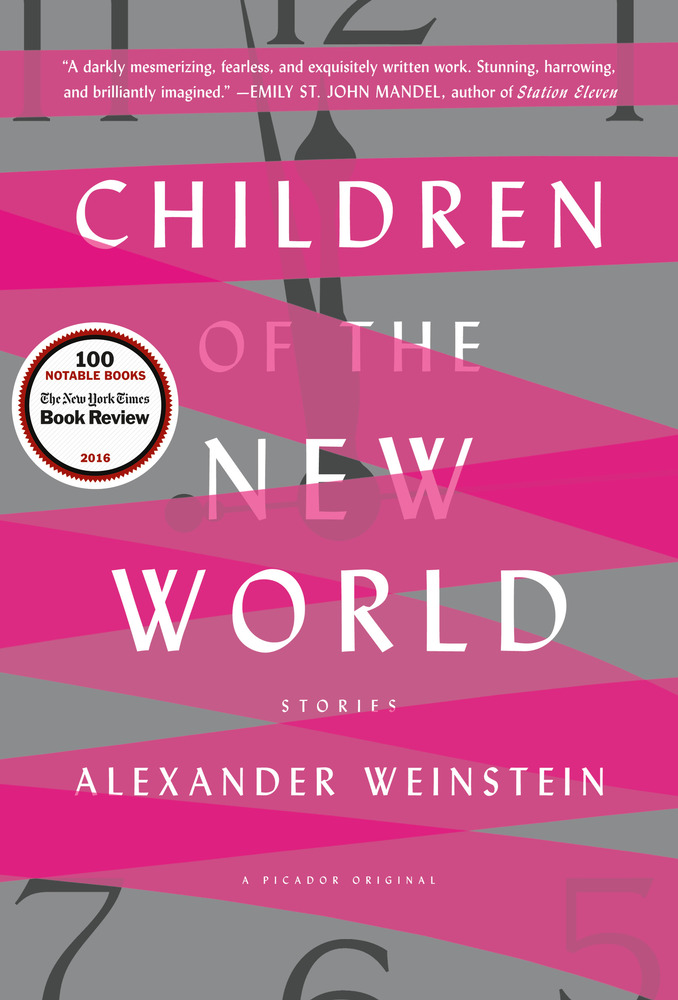Review: CHILDREN OF THE NEW WORLD by Alexander Weinstein

Review by MAGGIE NYE
Alexander Weinstein, director of the Martha’s Vineyard Institute for Creative Writing and author of the technology-obsessed debut collection Children of the New Word, is a preacher of the “human reboot,” a revolutionary outpouring of love, empathy, and care. It’s a term he uses in an interview with Michigan Quarterly Review to explain what he sees as the only way we can heal our world, which is spiraling towards the dystopia of his imagining.
Indeed, the stories in Children of the New World depict a recognizable near-future very much in need of healing. The story worlds are beset by degradations of every conceivable variety: in “Heartland,” the occupants of a depressed Indiana town have all sold off their topsoil, making clay pits of their neighborhoods; in “Iceage,” a massive freeze has turned the United States into a giant icescape; in “Fall Line,” global warming is the backdrop for the last season of an obsolete ski resort.
And then there are the interpersonal degradations: the collapses of communities, families, and romantic relationships, which are all exacerbated by the social technologies that saturate these stories. In a 2016 talk at Google, Weinstein discusses the “new emotions” we find ourselves grappling with as modern technology users. “The emotion of an empty inbox,” for example, or an “unmessaged dating profile.” Through he is referring, here, to our real-world experience, these are feelings his characters experience acutely. At their core, he concedes, these are not actually new emotions, but primitive human anxieties; they’re evolutions of loneliness.
One of Weinstein’s greatest fears for our emerging world, a fear his characters are forced to live out, is that our technologies—our highly customizable virtual landscapes and socialscapes—will replace our degraded realities so fully that we’ll have no recourse and no desire to cope with the challenges of restoring our natural resources, accepting the imperfections of the body, or trying to understand perspectives that don’t align with our own.
“Migration” explores the most developed examples of these fears. In this story, the real world is deserted and human inhabitants live out the majority of their lives from inside their homes, insulated from other people by virtualscapes tailored to their exact preferences. The capability of virtual avatars to express idealized bodies and populate those bodies with unlimited sex organs turns avatars into full-body pleasure zones, rendering IRL sexual encounters between the narrator and his wife obsolete.
But sex isn’t the only missing intimacy. Anna, the wife of the unnamed narrator, is a virtual landscaper able to create stunning landscapes with perfect light: “the eternal hue of late afternoon.” She creates these landscapes for big clients, like Whole Foods, but she makes them for her family, too. The narrator recalls how he and his son, Max, used to don their body suits and go walking in the landscape when his son was a young boy, but these days, to avoid the growing disconnect he feels with his now-teenaged son, he simply brings up Max’s saved avatar. “The simulator gives his child’s sweetness a disturbing digital timbre,” the narrator says, “but it’s close enough.”
“The Pyramid and the Ass” is perhaps the zaniest story in the collection. Briefly, Douglas Duncage, now on his ninth reincarnation, is experiencing a confusing awakening to the feelings of political dissent his earlier incarnations died pursuing. In the story, which has farcical parallels to the Bush-era occupation of Iraq, Americans, who are now regularly reincarnated using natural resources heavily mined from Tibet, are so far removed from independent critical thought that a government-engineered technology called “Innereye” dictates the majority of cognitive experience.
The story opens with the main character Douglas Duncage watching the Oscars. When a kimono-clad actress receives her award, “[s]atellite impulses [trigger] the release of serotonin and his eyes [well] with tears.” It’s a comical and casually-laid detail that underscores a possible future relationship to technology that is disturbingly easy to envision: the abdication of the empathetic response. Many readers, myself included, have found comparisons between Weinstein’s collection and the popular dystopian television series Black Mirror, for the ways they seems to warn of the devastating future our technologies could lead us to, but when I asked him what he thought of the show, he confessed he’d never seen an episode. With enough prodding he finally caved. He said he liked the show, which wasn’t surprising. He thought it was smart, but he was worried.
“My work isn’t that dark, is it?” he asked me. For Weinstein, hope is paramount to the success of his stories. These characters, no matter how bleak their lives, how lonely their circumstances, are offered the chance to confront and rediscover what it means to be a human in a world greatly in need of compassion and care. They are offered the opportunity to participate in the human reboot, which is how I should have answered his question. I should have said that unlike Black Mirror, Children of the New World extends this invitation to every reader, asks every reader to be part of a human solution.